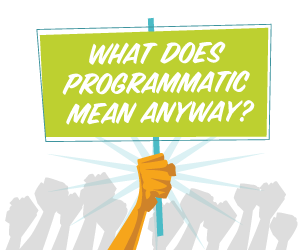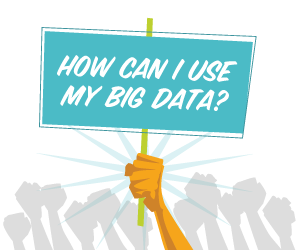How Search Retargeting Kick Started The Programmatic Marketing Revolution
Buzz word or not, “programmatic marketing” is here to stay. Those CMOs who’ve embraced it have largely found their spend is more efficient, their targeting is more accurate, their customers are happier, and they have insights that were unheard of just a few years ago. But, programmatic marketing had a surprising start, coming in part […]
Buzz word or not, “programmatic marketing” is here to stay. Those CMOs who’ve embraced it have largely found their spend is more efficient, their targeting is more accurate, their customers are happier, and they have insights that were unheard of just a few years ago. But, programmatic marketing had a surprising start, coming in part from the world of Search Retargeting.

Image courtesy of Chango
Let’s back up a little bit and start by explaining one of the biggest buzzwords of 2013: big data. “Big data” simply means lots and lots of data that sits in different places, making it hard to use. Even more simply, it means more data than you have used in your marketing before.
And, why should you care? Well, more data makes you smarter, and being smarter allows you to make better decisions about who to target, when to target them, and (in this real-time bidding media world) at what price.
So, you’ve got big data, but it’s hard to use — that’s where programmatic marketing steps in. Programmatic refers to the method and tools that make all that lovely data actionable.
When we started Chango, it was with the early vision to bring programmatic to all marketers. Media exchanges were just beginning to emerge and so we had the access to target the individuals that were relevant.
But what we needed to decide was which data set we could focus on to cut our teeth. We don’t have a history of doing things the easy way, and so the equivalent of throwing ourselves into the deep end was to pick the largest data set we could find.
Search Retargeting Comes Alive
The audience of this site will know more than most that there are few data sets larger than the searches that individuals do on the major engines every day, and for an idea of scale, we have billions and billions of those events – more than Yahoo! and Bing combined every month.
Search data also have a lifetime value; these data can degrade fast, sometimes becoming quite useless within days or hours, depending on the industry you are using it for.
So. that sounded like a fun challenge. :)
When a brand wants to find new customers using search retargeting, they compile a list of keywords that they are interested in and send it over with their display ad creative.
These terms are then held in a “live” system, waiting to match against individuals who have searched on those terms. When it comes to prospecting for brand new customers, it’s hard to beat targeting just the hand-raisers that have said they want what you have!
The technology to make all this happen became known as the PMP, or Programmatic Marketing Platform, and such a system allowed rules to be written that married disparate data sets together to create an output such as relevant advertising.
Sample Executions
The majority of marketers use Search Retargeting for direct response, measuring on a ROI (Return On Investment), CPA (Cost Per Acquisition) or ROAS (Return On Ad Spend) basis. They put media dollars in and expect a certain level of return. It requires intense, hands-on optimization at the keyword level.
As an example, there is a department store that uses search retargeting as an evergreen tactic. They target keywords such as “new shoes,” “dress sale” and “clothing coupon” to find new customers that are in the market right now. They also target brand keywords that relate to the clothing labels they carry in store to capture the dollars from individuals who don’t know they are a source for those items. And lastly, they use competitor brand terms for conquesting new dollars.
For an example in travel, think about someone like a rental car company. When better to target someone than when they are searching for information about their upcoming destination, their flights or perhaps their hotel?
Beyond Direct Response
More recently, marketers are starting to recognize the value of programmatic marketing for generating “brand awareness,” a typically expensive and often vague methodology. They are understanding that such an approach can remove that wastage and even make their dollars more efficient.
Consumer Packaged Goods (CPG) brands are among the first to adopt programmatic marketing, with companies like Kellogg’s being the poster child in the industry; they are using all this data to define more accurate audiences.
Imagine a new bio-degradable diaper product. Today, the manufacturer is looking for customers based on criteria such as “females, 2 kids in the house, moderate household income.” This set of criteria is okay, but very wasteful, as not all these individuals care enough about climate change to spend the extra dollars on the product.
Tomorrow, these brands will leverage intent signals such as “cares about environment,” “expecting a baby,” and “reads about BPA in children’s toys” — suddenly, they are spending less and finding the right people both more quickly and more cheaply than before.
Programmatic Everywhere

Image courtesy of Chango
It’s the future that really excites me, though. We spend a lot of time talking about display ads, mobile and video; and with our integration with FBX (and now Facebook’s Newsfeed for search data), we even talk about social.
But what about out-of-home (OOH) advertising, TV, radio, etc.? And what about the future we see coming from augmented reality, Google Glass and who knows that else? All of these environments will be desirable to marketers, and the idea of the “right place” will become very complicated indeed.
Think about that – you want to target a mum who cares about environmental issues with a biodegradable diaper – when do you do it? On her way to work through her Glass, on her digital radio at her desk, on the billboard as she pulls into the supermarket parking lot, outside her kid’s school whilst waiting to collect them…?
Such decisions require massive data and will require programmatic systems that can find it, process it and make it actionable. Our guess at the revolution that was to come appears to have been right. For kids of the ’80s: “I love it when a plan comes together!”
Contributing authors are invited to create content for Search Engine Land and are chosen for their expertise and contribution to the search community. Our contributors work under the oversight of the editorial staff and contributions are checked for quality and relevance to our readers. The opinions they express are their own.
Related stories
New on Search Engine Land